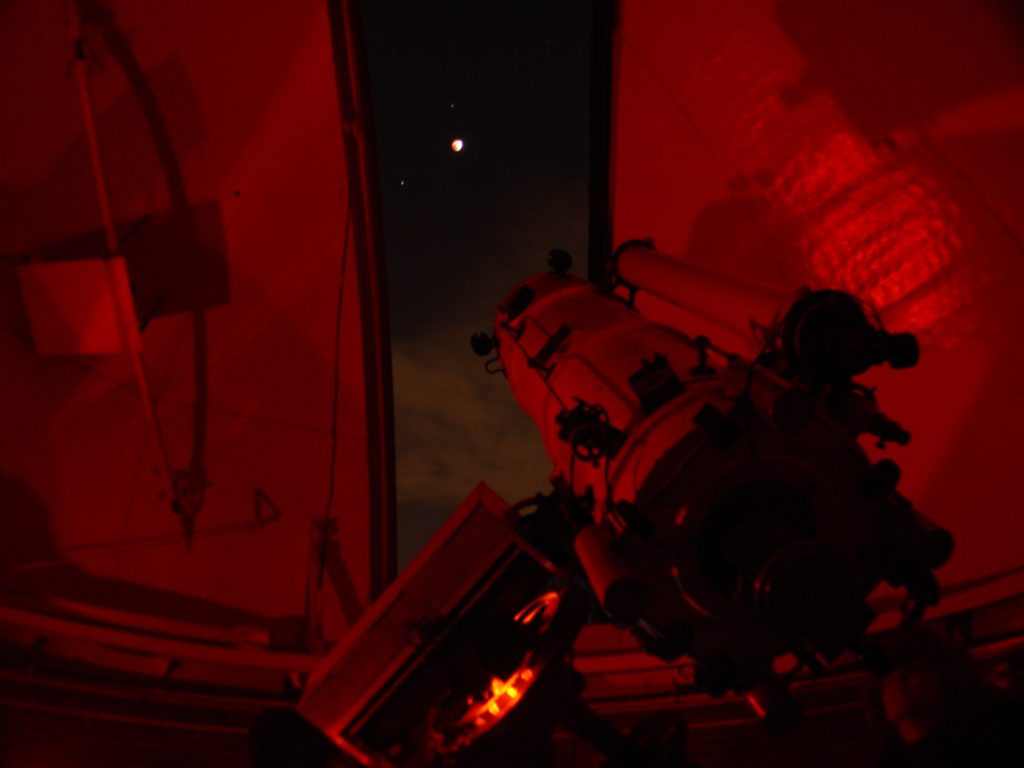 Lunar eclipses are a celestial treat, but for many observers it seems like either the clouds know when to interfere or the eclipse inconveniently happens during the early morning hours.
Lunar eclipses are a celestial treat, but for many observers it seems like either the clouds know when to interfere or the eclipse inconveniently happens during the early morning hours.
This was not the case for the total lunar eclipse of February 20, 2008.Shown above in the three-second exposure, Dyer Observatory’s beloved Seyfert Telescope is suffused in the red glow of the interior dome lights, which provide ample lighting for one to be able to see while walking but not enough to ruin night vision of the dark-adapted eye. The dome and telescope are not the only objects bathed in a red glow – a red hue can also be easily observed reflecting off of the Moon. During a lunar eclipse, the Moon passes through the shadow of the Earth, which diminishes the light that it receives from the Sun; however, because Earth has an atmosphere, the Moon is not completely darkened even when the Sun is totally obscured by our planet. As sunlight enters our atmosphere, the bluer light rays are preferentially scattered, which makes our sky appear blue. Some of the sunlight from the redder side of the visible spectrum is able to make it completely through our atmosphere and back out into space. Refraction by our atmosphere bends the light ray paths, allowing some of the red light to fall on the Moon.
This eclipse was also special for Dyer Observatory – it coincided with the 102nd anniversary of the birth of Mr. John H. (“Jack”) DeWitt, one of the primary individuals responsible for the creation of Dyer Observatory. As celebrations were going on and visitors watched the eclipse with their bare eyes, the Seyfert telescope was focused on the bright object just to the left of the eclipsed Moon – Saturn. Saturn is currently visible in the late evening sky now, rising around 9pm local time and just to the east of its brighter neighbor, Jupiter. This year, Jupiter and Saturn will appear very close to one another in the sky, an arrangement known as a conjunction. In fact, Jupiter and Saturn will be one-quarter of a degree apart (half the width of the full Moon) on December 21, 2020 – close enough that both will be visible simultaneously, along with their moons, in a telescope eyepiece.
Photo by Dr. Billy Teets
<- Previous July 10, 2020 Next ->
Tucked up among the wooded hilltops of northern Brentwood, Vanderbilt Dyer Observatory is considered by many to be a hidden treasure of the area. Visitors to our satellite campus not only learn about some of the cutting-edge discoveries and science in astronomy but they also get a dose of nature, history, and many other things while here. Over the years, we at Dyer Observatory have made the preservation of our facility and grounds a key mission. Preservation not only entails things such as maintaining our telescopes — it also includes keeping a record of days passed. Since 1953, we have amassed a number of interesting images, pieces of equipment, and ephemera. Every day tends to bring new surprises. In continuing our tradition of public education and outreach, Stellar Finds regularly provides an image and description of the diverse paraphernalia associated with Vanderbilt Dyer Observatory and the history of astronomy at Vanderbilt University.